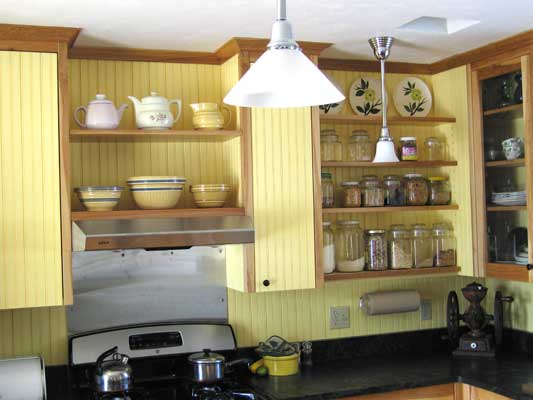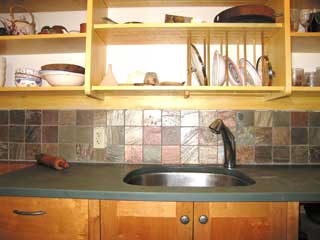
Ecological Cabinetry
Thoughts on Counters
Accessibility
Featured Project: The Horton House
Ecological Cabinets
(click on photos to enlarge)

An ecological
kitchen should be simple, compact, use
native materials where possible, and conserve materials.
These
are partially built in place, one
of the best ways to save on material..

Pine from nearby managed forests, painted
with low VOC water based paints.
Green Kitchens
Plywood: We use no particle board. Our cabinet boxes are made from 3/4” birch Purebond plywood, which is made with a soy based adhesive rather than the usual urea-formaldehyde glues.
Lumber: We are very interested in where the lumber that goes into our cabinets comes from. We want to use good quality wood, that has been harvested in sustainable ways.
FSC certification is one way of addressing that. Right now we can get white oak, red oak, cherry, and maple in FSC, and other species can be special ordered. FSC lumber, which usually costs somewhat more than similar uncertified lumber, has chain of custody documentation which certifies that the wood has been sustainably harvested, and sometimes also that it was grown within 500 miles of where it will be used.
We have a variety of local sources for hardwoods and softwoods where we have personal knowledge of the source.
We use a lot of pine lumber, particularly beautiful eastern white pine, for drawers, shelves, and sometimes for drawer fronts and cabinet doors. We have a source in New Hampshire for FSI certified pine. This is beautiful and beautifully milled pine grown within about 200 miles of the yard where we buy it. FSI certification means that the forests where the lumber is cut are sustainably managed.
We also offer recycled oak, heart pine, and chestnut.
This is a complicated issue, with lots of trade-offs. We work closely with all our suppliers to find out where their wood comes from, whether it carries a label or not. Let's talk.
Counters: We prefer natural materials for out counters. Most of our kitchens have some amount of wood counter, either slabs made in our shop, or commercially available butcher block with an oil finish. We like stone counters, particularly around a sink or next to a stove, and are partial to slate from Vermont quarries. We've also been using linoleum in places where a plastic laminate might be called for. Linoleum is a natural product, made from jute, stone dust, linseed oil and other materials, and makes an interesting counter, which is softer than laminate but quite tough in use. (click to Thoughts on Counters)
Finishes: We offer several types of finishes. Our default finish has been an oil-based satin polyurethane, which is easy to apply, tough, durable, and cost effect, but not particularly “green”.
We have worked extensively with water based varnishes. So far, we've found none that are as tough or good looking as the oil-based poly. We feel this is a suitable finish for insides of cabinets and for drawer boxes, but not for the parts of the cabinetry that you will be looking at. Even so, more coats are needed to get decent protection.
We are now offering tung-oil-based finishes from Sutherland Welles. These are beautiful, low VOC oil finishes made in a variety of formulations. This company has put a lot of thought into developing finishes that are tough and have low VOC levels. We're still learning about these finishes. They may require a bit of annual upkeep, and there may be a small additional charge.
Recycling: One of the best ways to save money and have a more green kitchen is to reuse elements from your existing kitchen, or from other sources. We've often used nice old sinks or other appliances. An old counter can sometimes find a new home. A old table can become an island. An old “hoosier” cabinet from the '20s can replace a segment of new cabinetry.
Reuse of this kind can be a green choice. But it also saves money, and adds an element of variety and interest to a kitchen that all new, totally matching cabinetry cannot provide. In these things, though, layout comes first. Use that old sink when it really fits the design.
Design Issues:Getting the right materials is only part of it. Put as much thought into the design as into materials choices. Here are some considerations that often come up in our projects.
Compact Design: We think a compact design saves cost, uses less space, and requires less material and labor to construct. As with building a new house, a smaller, smarter design is more ecological than a huge kitchen with all the ecological bells and whistles.
Appliances: Choose efficient, low energy use appliances. Extra large stoves, sinks, and refrigerators are very popular at the moment. Usually the more conventional sizes will work fine, and conserve your valuable counter space. Also look for appliances which will be reliable, and can be easily repaired – that's part of ecology, too.
Dish Drainers: We've been making these “wonder no-dry” dish drainers for many years. The idea is, you wash and rinse the dishes, then put them away wet. The excess water drips back into the sink. It saves space, and makes hand washing easy. Though many customers also have a dishwasher, it really is about as fast to hand wash as use a machine. In a very small kitchen, with minimal storage, eliminating the dishwasher can be one way to find crucial storage space. No electricity required.
Open Shelves: It's good to use green materials, but also to use less material. Open shelves is one way to simplify your kitchen, and reduce the material used to build it. Of course, it saves money. A walk-in pantry is another device that does this. Building cabinets in place, or eliminating unnecessary elements (such as some cabinet backs) are other ways to reduce the total amount of materials consumed in your kitchen project.
Recycling, etc: Make sure you provide for composting, recycling, and the other “ecological” chores we all now do.
©2009 Old Barn Vermont, LLC -- contact webmaster.



